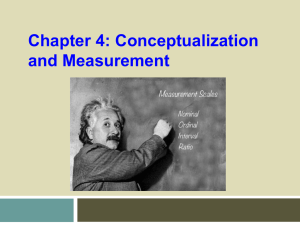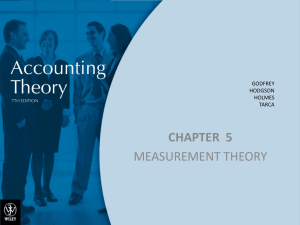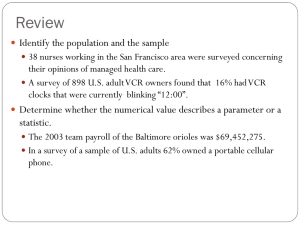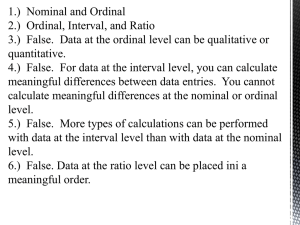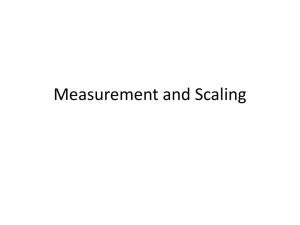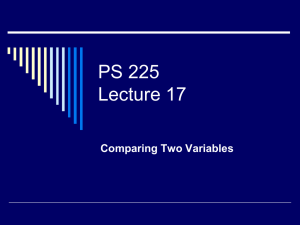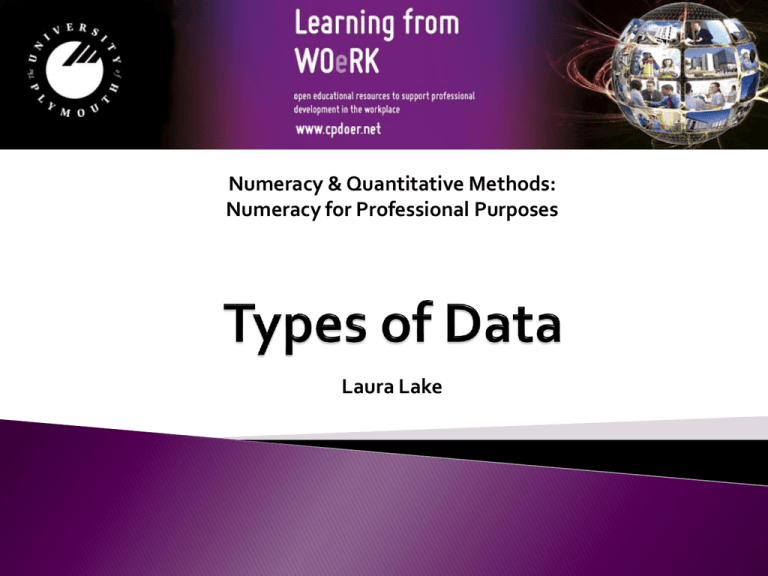
Numeracy & Quantitative Methods:
Numeracy for Professional Purposes
Laura Lake
Introduction
• When collecting or gathering data we collect data from
individuals cases on particular variables.
• A variable is a unit of data collection whose value can vary.
• Variables can be defined into types according to the level of
mathematical scaling that can be carried out on the data.
• There are four types of data or levels of measurement:
1. Nominal
2. Ordinal
3. Interval
4. Ratio
Nominal data
• Nominal or categorical data is data that comprises of categories
that cannot be rank ordered – each category is just different.
• The categories available cannot be placed in any order and no
judgement can be made about the relative size or distance from
one category to another.
• What does this mean? No mathematical operations can be
performed on the data relative to each other.
•Therefore, nominal data reflect qualitative differences rather
than quantitative ones.
Nominal data
Examples:
What is your gender?
(please tick)
Did you enjoy the
film? (please tick)
Male
Yes
Female
No
Nominal data
•Systems for measuring nominal data must ensure that each
category is mutually exclusive and the system of
measurement needs to be exhaustive.
• Variables that have only two responses i.e. Yes or No, are
known as dichotomies.
Ordinal data
• Ordinal data is data that comprises of categories that can be
rank ordered.
• Similarly with nominal data the distance between each
category cannot be calculated but the categories can be
ranked above or below each other.
• What does this mean? Can make statistical judgements and
perform limited maths.
Ordinal data
Example:
How satisfied are you with the level of
service you have received? (please tick)
Very satisfied
Somewhat satisfied
Neutral
Somewhat dissatisfied
Very dissatisfied
Interval and ratio data
• Both interval and ratio data are examples of scale data.
• Scale data:
• data is in numeric format (£50, £100, £150)
•data that can be measured on a continuous scale
• the distance between each can be observed and as a
result measured
• the data can be placed in rank order.
Interval data
• Interval data measured on a continuous scale and has no
true zero point.
• Examples:
•Time – moves along a continuous measure or seconds,
minutes and so on and is without a zero point of time.
• Temperature – moves along a continuous measure of
degrees and is without a true zero.
Ratio data
• Ratio data measured on a continuous scale and does have a
true zero point.
• Examples:
• Age
• Weight
• Height
Hierarchical data order
•These levels of measurement can be placed in hierarchical
order.
Ratio
Interval
Ordinal
Nominal
Hierarchical data order
• Nominal data is the least complex and give a simple measure
of whether objects are the same or different.
• Ordinal data maintains the principles of nominal data but
adds a measure of order to what is being observed.
• Interval data builds on ordinal by adding more information
on the range between each observation by allowing us to
measure the distance between objects.
• Ratio data adds to interval with including an absolute zero.
Hierarchical data order
• Knowing the hierarchy of data is useful.
•Why? It is possible to recode or adjust certain types of data
into others.
• Can go from most complex (interval and ratio) to least
complex (nominal) but cannot go the other way around.
• Interval/ratio can be re-formatted to become ordinal or
nominal, ordinal can become nominal.
Hierarchical data order
• Example: salary data for is often recorded as interval data
(i.e. just a number).
• Why? Because it can then be analysed in many ways:
• Any mathematical operation e.g. average salary
• reformatted into ordinal or nominal data e.g. salary
bands (£10,000 to £14,999, £15,000 to £19,999)
Hierarchical data order
• If salary data is collected as an ordinal variable i.e. in salary
bands, then it becomes impossible to perform mathematical
operations such as finding the average salary.
• So, if possible data such as this should be collected as scale
data and these issues should be thought about at the research
design stage.
Data types – important?
• Why do we need to know what type of data we are dealing
with?
• The data type or level of measurement influences the type of
statistical analysis techniques that can be used when
analysing data.
• See the next set of lectures on descriptive statistics.
References
Bryman, A. (2008) Social Research Methods. 3rd Ed. Oxford: Oxford
University Press.
David, M. and Sutton, C. (2011) Social Research : An Introduction.
2nd ed. London: Sage.
This resource was created by the University of Plymouth, Learning from WOeRk project. This project is funded by HEFCE
as part of the HEA/JISC OER release programme.
This resource is licensed under the terms of the Attribution-Non-Commercial-Share Alike 2.0 UK: England
& Wales license (http://creativecommons.org/licenses/by-nc-sa/2.0/uk/).
The resource, where specified below, contains other 3rd party materials under their own licenses. The licenses
and attributions are outlined below:
1.
The name of the University of Plymouth and its logos are unregistered trade marks of the University. The University reserves all rights
to these items beyond their inclusion in these CC resources.
2.
The JISC logo, the and the logo of the Higher Education Academy are licensed under the terms of the Creative Commons Attribution
-non-commercial-No Derivative Works 2.0 UK England & Wales license. All reproductions must comply with the terms of that license.
Author
Laura Lake
Institute
University of Plymouth
Title
Numeracy & Quantitative Methods
Numeracy for Professional Purposes
Description
Overview of data types
Date Created
May 2011
Educational Level
Level 4
Variable, nominal, ordinal, interval, ratio, mutually exclusive, exhaustive,
hierarchical order, dichotomies.
Keywords
©University of Plymouth, 2010, some rights reserved
Back page originally developed by the OER phase 1 C-Change project



